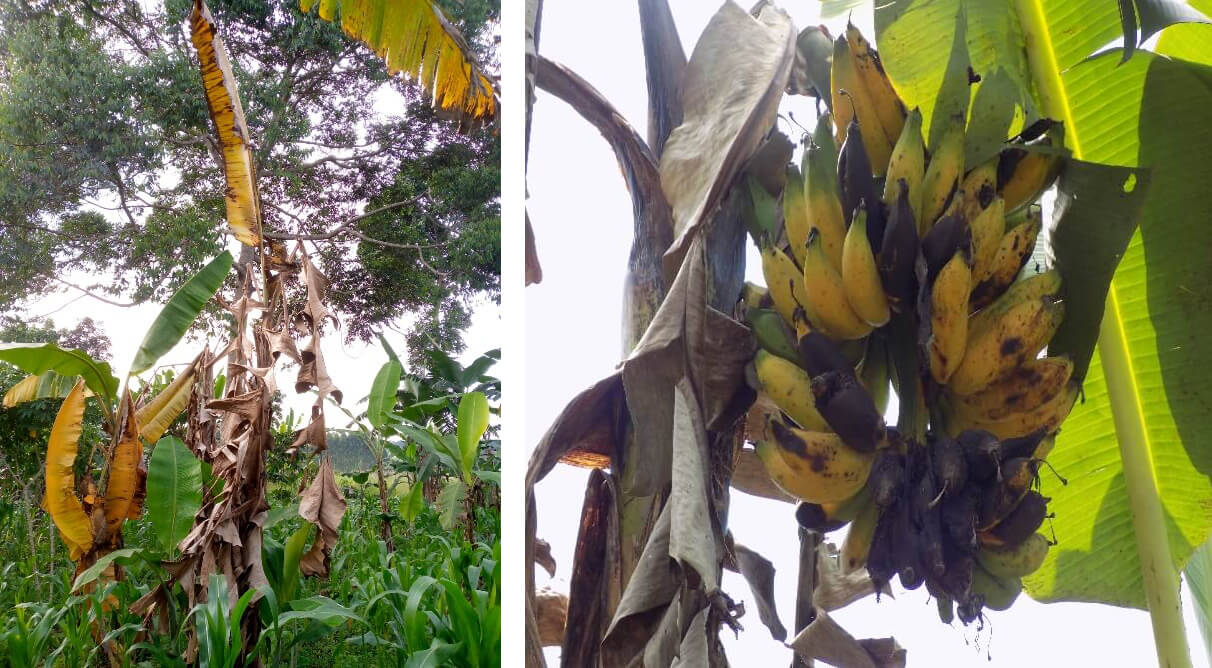The Phage quote, which I first heard at the 4th phage Laboratory training workshop organized by Phages for Global Health (PHG) in 2020, continues to fuel my dedication to phage research aimed at achieving sustainable solutions to disease management. “Give a woman or man a phage and you may treat one particular infection once. Teach a woman or man how to isolate phages and you will remove multiple infections from multiple pathogens (PHG). This training, held at Muhimbili University of Health and Allied Sciences (MUHAS) in Tanzania, equipped me with the essential skills and foundational knowledge needed to launch the Xanthomonas phage biocontrol project in Uganda.
Agriculture is the backbone of Uganda’s economy, with the cooking banana, locally known as Matooke, serving as a key staple. This perennial crop has a pseudostem or ‘false stem’ made up of overlapping leaf sheaths. The parent plant produces one banana fruit by the second year and continues to yield fruit every eight months from each sucker. Matooke is not only a staple food but is integral to the Ugandan culture, featured prominently at social events such as burials, weddings, bride price ceremonies, and last funeral rites. Traditionally, cooking Matooke involves peeling, wrapping in banana leaves, steaming over firewood or charcoal, mashing and serving with any sauce. Other banana varieties include plantains for roasting, apple banana (Ndiizi) for desserts, and types like Mbidde, Kisubi and Kayinja for beer.

Figure 1. Banana plants carrying a single bunch: Reproduced from: https://eagle.co.ug
Banana cultivation faces severe threats from diseases, particularly Banana Xanthomonas Wilt (BXW). The disease can devastate banana plantations, causing up to 100 % loss if not managed. The disease continues to spread across all banana-growing regions worldwide, posing a significant threat to global food security.
The disease is caused by Xanthomonas vasicola pv. musacearum (Xvm), a gram-negative aerobic bacterium. It leads to yellowing and wilting of leaves, premature ripening of fruit, and eventually plant death. BXW is currently managed through a combination of practices, including machinery sterilization, burying or burning of infected plants, crop rotation, herbicide treatments and natural remedies such as cow urine and ash. While these practices may help reduce the disease burden, they do not achieve complete elimination due to the challenges farmers face in effectively implementing them. These methods are demanding, cumbersome, and expensive, and they can also promote chemical bacterial resistance. As a result, they are less effective at controlling the disease.

Figure 2. Symptoms of BXW in banana plants. Left. Yellowing and wilting of banana leaves. Right: Premature ripening of banana fruit. Photo courtesy of the Xanthomonas phage project, Uganda.
The Xanthomonas phage project aims to provide alternative or supplementary strategies for effectively managing BXW. Phages represent a promising solution to address this persistent challenge. To date, phages targeting Xvm have been isolated from diverse environments including sewage and plant rhizosphere and phyllospheres. The phages have demonstrated the ability to eliminate Xvm in vitro, with efficacy ranging from 70% to 100%. The next step involves formulating a phage cocktail and evaluating its effectiveness on banana plants in field settings.
Mentorship is a crucial component of this phage research project. Through dedicated mentoring, students at undergraduate, postgraduate, and technician levels have acquired both theoretical knowledge and practical skills in phage biology through hands-on research projects. This mentorship initiative has ensured the transfer of knowledge and expertise, fostering a generation of scientists equipped to tackle challenges in phage research and biocontrol.

Figure 3. Some of the students mentored on this project (Left) and Zone of lysis on Xvm lawn (Right). Photo courtesy of the Xanthomonas phage project, Uganda.
Conclusion and significance
This project is more than just a local initiative; it is a call to the global scientific community. By collaborating with leading researchers, institutions, and organizations, we can pool expertise, resources, and knowledge to develop robust phage-based bio-control products for crop protection. We welcome collaborations that foster exchange of knowledge and skills, facilitate student exchanges, and build research capacity. We invite those interested in phage diversity to connect with us for access to unique or related phages from Uganda.
We extend our heartfelt gratitude to OWSD/UNESCO and IFS for funding that has supported phage research. We also appreciate Phages for Global Health (PGH) for their invaluable training, which has greatly advanced phage research capacity across Africa. Additionally, we are thankful to Phage Team Uganda, Africa Phage Forumand the Phage Directory for their ongoing dedication and collaborative support.
Want more?
This is Ritah’s second Capsid & Tail guest post: check out her first one here, where she shared her experience attending the 4th Phages for Global Health workshop in Tanzania and highlighted the importance of phage training in advancing research across East Africa.










